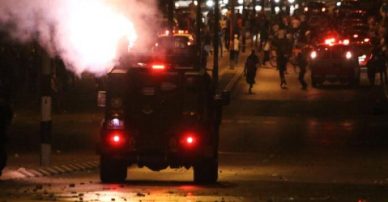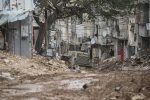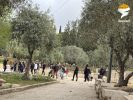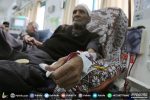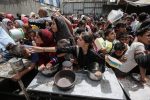These days coincide with the anniversary of the outbreak of Al-Aqsa Intifada in 2000 which marked a turning point in the Palestinian cause changing many equations. Due to its revolutionary action the Israeli occupation withdrew from Gaza; initiating a new phase for the liberation of Palestine.
The spark of the intifada broke out 18 years ago after the Israeli war criminal the leader of the Likud Party at the time Ariel Sharon along with Israeli settlers stormed the courtyards of Al-Aqsa Mosque and tried to desecrate its yards and its symbolic place through their provocative actions.
The Palestinian people faced this provocation with courage with their bare chests providing examples of sacrifice and dignity as they always did to protect Al-Aqsa Mosque and Jerusalem and the Palestinian cause as a whole.
The spirit of resistance and redemption
The Palestinian people faced Sharon’s intrusion into Al-Aqsa with strength and firmness as dozens of martyrs and rivers of blood were scattered on the ground in expression of this spirit of resistance. The Palestinian people have proved that the stolen rights can only be restored through the united will of the people around the project of resistance and protection of rights.
Al-Aqsa Intifada or what is known as the Second Intifada was characterized by frequent armed confrontations and escalating military actions between the Palestinian resistance and the occupation in which 4412 Palestinians were killed and 48322 were injured. More than 1000 Israeli soldiers and settlers were killed and more than 5000 were wounded.
Different stages
The Palestinian resistance during Al-Aqsa Intifada passed through many stages. It started with a great popularity that swept through the Palestinian cities and towns. The Palestinian people participated in it gradually starting clashes with the occupation soldiers at the entrances of towns and cities that led to the injury of many Palestinians in most of the provinces. The images of confrontations and throwing stones appeared on TVs as the confrontations later led to the martyrdom and injury of many Palestinians in most of the provinces.
Child Faris Awda: One of the icons of Al -Aqsa Intifada
The stage of military engagement which slowly infiltrated the scene began. There were some military clashes of individual resistance fighters after which some military groups from the Palestinian factions led the path and that period was a tidal wave between the Palestinian resistance and the occupation soldiers.
The Palestinian response began to widen and the circle of engagement began to affect the occupation soldiers and settlers at the main roadblocks and streets of the West Bank as well as the storming of the settlements and carrying out military operations which led to the spread of fear in the ranks of the occupation after the casualties they incurred.
The resistance gradually developed with the continuation of the Intifada. The Palestinian factions were able to form military groups in most Palestinian cities. Their performance developed and a new phase began in the conflict. This was the stage of the human-bombing attacks that constituted the greatest blow to the occupation. The scenes of buses restaurants and charred hotels were the most prominent feature at that stage.
The stage of human-bombing attacks continued during the Intifada’s early years before another stage began to emerge. It was the rockets and mortars stage. The first Qassam rocket launched from Gaza towards a settlement was on 26 October 2001 which now is the most disturbing point for the occupation.
Resistance
The Palestinian resistance was characterized by several advantages imposed by the facts on the ground during Al-Aqsa Intifada perhaps the most prominent of which was the leadership which was engaged in the battle and the Palestinian consensus on the resistance approach. The Palestinian factions and their leaders acted in the field. The Palestinian unity and the consensus on the resistance were the most prominent features among the Palestinians.
The resistance was characterized by its durability over the years of the Intifada and during the period of resistance and implementation it relied on the abilities of its people who invented various means and tools of resistance. Self-reliance was one of the characteristics of the resistance at the time.
The direct and strong response of resistance to any Israeli violation and aggression was a prominent feature of the resistance approach and it imposed certain deterrence to the occupation and its arrogance.
Implications
With the development of martyrdom attacks and hitting the depth of the occupation Israel began the construction of the separation wall in 2002 to limit these operations and infiltration of Palestinians and fighters to Jerusalem and the occupied lands.
The Intifada was also marked by the assassination of several prominent Palestinian leaders headed by the founder of the Islamic Resistance Movement (Hamas) Sheikh Ahmed Yassin the leader of the movement Abdel Aziz Rantisi in addition to the Secretary General of the Popular Front Abu Ali Mustafa and the leader of the armed wing of the Palestinian National Liberation Movement (Fatah) Raed Al Karmi.
The occupation destroyed the Palestinian infrastructure in the West Bank during the Intifada while also causing heavy losses the most striking of which was the tourism sector and the economy of Israeli settlements. This also led to destroying the notion of the invincible army that Israel used to describe its army with and the insecurity and instability in all areas of the Palestinian land where the resistance benefited from the experience of resistance in the years of the Second Intifada sending a message that the security of settlers is shaken and that the Palestinians do not fear the occupation or its army.
It seems that the root of revolution which was ignited by the Intifada is being renewed. The Palestinian people continue to fight the enemy and to confront its aggressions and violations in Jerusalem the West Bank the Gaza Strip and in the 1948 Territories as illustrated by the Great March of Return.


